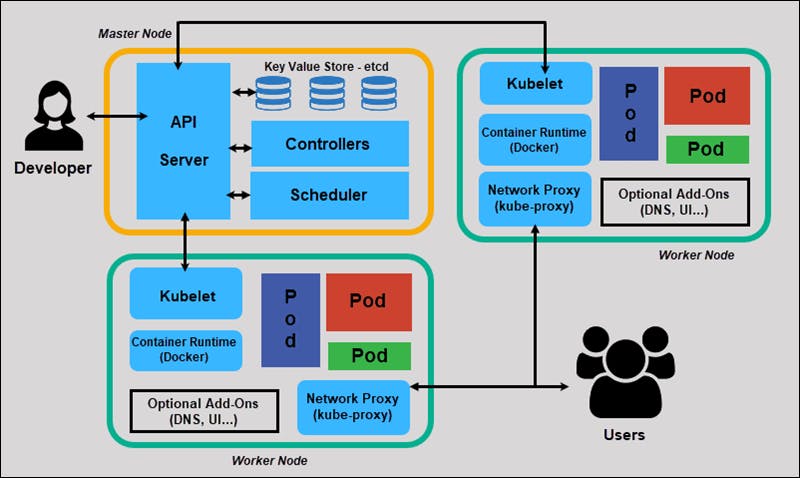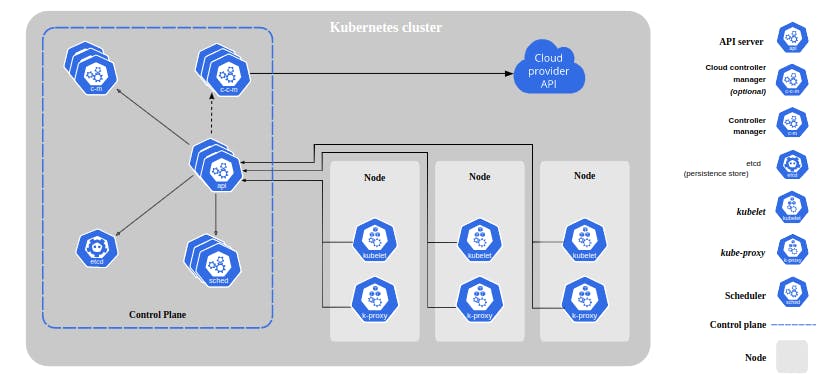Table of contents
Kubernetes is a powerful open-source platform that automates the deployment, scaling, and management of containerized applications. It was developed by Google and is now maintained by the Cloud Native Computing Foundation (CNCF). In this article, we'll take a look at what Kubernetes is, what it's used for, and why it's so popular.
Architecture of Kubernetes

The above diagram shows the basic architecture of a Kubernetes cluster. The main components of a Kubernetes cluster are the Master and the Nodes.
The Master is the brain of the cluster and is responsible for managing the entire cluster. It contains several components such as the API server, etcd, and the controller manager. The API server is the main point of interaction for users and other components in the cluster. It exposes the Kubernetes API, which is used to create, read, update and delete resources in the cluster. etcd is a distributed key-value store that stores the configuration data of the cluster. The controller manager is responsible for the overall state of the cluster.
The Nodes are the workers of the cluster and are responsible for running the pods. Each node has a kubelet, which is responsible for communicating with the master and maintaining the state of the pods on that node. The nodes also have a container runtime, such as Docker, which is responsible for running the containers.
Pods are the smallest deployable units in Kubernetes. They are the basic building blocks of the system and can contain one or more containers. Pods provide shared storage and network resources for the containers they contain.
Services are the way to expose your application to the outside world. They provide a stable endpoint for your application, and they can load balance the traffic between pods.
Deployments are the recommended way to manage the creation and scaling of pods. They ensure that the desired number of replicas of your applications are running at all times.
In summary, Kubernetes provides a powerful and flexible platform for automating the deployment, scaling, and management of containerized applications. With its ability to automate many of the tasks involved in deploying and managing applications, it makes it easy for organizations of all sizes to deploy and manage complex applications at scale.
Components of Kubernetes

The above diagram shows the main components of a Kubernetes cluster and how they interact with each other.
A Kubernetes cluster consists of a set of worker machines, called nodes, that run containerized applications. Every cluster has at least one worker node.
The worker node(s) host the Pods that are the components of the application workload. The control plane manages the worker nodes and the Pods in the cluster. In production environments, the control plane usually runs across multiple computers and a cluster usually runs multiple nodes, providing fault tolerance and high availability.
This document outlines the various components you need to have for a complete and working Kubernetes cluster.
How does it work?
The basic building block of Kubernetes is the pod, which is a group of one or more containers that share the same network namespace and storage resources. Pods provide a way to group related containers and make it easier to manage them as a single unit.
The main components of a Kubernetes cluster are the Master and the Nodes. The Master is the control plane of the cluster and is responsible for managing the entire cluster. It contains several components such as the API server, etcd, and the controller manager. The API server is the main point of interaction for users and other components in the cluster. It exposes the Kubernetes API, which is used to create, read, update, and delete resources in the cluster. etcd is a distributed key-value store that stores the configuration data of the cluster. The controller manager is responsible for the overall state of the cluster.
The Nodes are the workers of the cluster and are responsible for running the pods. Each node has a kubelet, which is responsible for communicating with the master and maintaining the state of the pods on that node. The nodes also have a container runtime, such as Docker, which is responsible for running the containers.
When an application is deployed on Kubernetes, it is defined using a set of manifests, which are written in YAML or JSON. These manifests define the desired state of the application, including the number of replicas, the container images to use, and the resources required by the application.
When a manifest is submitted to the Kubernetes API server, the API server validates the manifest and creates the corresponding resources in the cluster. The controller manager then monitors the state of the resources and ensures that they match the desired state. If the actual state differs from the desired state, the controller manager makes changes to the resources to bring them back in line.
Kubernetes also provides several other features such as automatic load balancing, automatic configuration of storage volumes, and automatic rolling updates. These features make it easy to deploy and manage complex applications at scale.
In summary, Kubernetes works by providing a set of APIs and command-line tools that can be used to manage and orchestrate containers. The basic building block of Kubernetes is the pod, which is a group of one or more containers that share the same network namespace and storage resources. The main components of a Kubernetes cluster are the Master and the Nodes. The Master is responsible for managing the entire cluster, while the Nodes are responsible for running the pods.
I hope this article gives you a good understanding of what Kubernetes is and how it works. Let me know if you have any questions or if you need more information. Keep "Unlocking DevOps Excellence and Kubernetes Mastery!" with this series.

